Want to make your space more appealing and beautiful then add some of the plants that looks like bamboo but isn’t. There are many different types of plants that still exist and we never heard of it but still it also is beneficial to the indoor environment. It is useful to the indoor and outdoor environment because it absorbs carbon dioxide and helps to purify the air and still provide oxygen. In this blog I will talk about the various plant that looks like bamboo.
Plant that Looks Like Bamboo
Below are the 8 plant that looks like bamboo and they are very similar to the appearance of a bamboo but isn’t. Some of these plants are popular ornamental plants but not all can be grown indoors in house while mostly adds on the outdoor category of plants. Here is the explanation one by one of each lookalike or type of bamboo:
| Plant Name | Family | Hardiness zone |
| Lucky Bamboo | Asparagaceae | 10 – 12 |
| Horsetail | Equisetaceae | 4 – 9 |
| Heavenly Bamboo | Berberidaceae | 6 – 9 |
| Parlor Palm | Arecaceae | 10 – 12 |
| Japanese Knotweed | Polygonaceae | 4 – 10 |
| Dumb Cane | Araceae | 10 – 12 |
| Giant Cane grass | Poaceae | 6 |
| Bamboo Palm | Arecaceae | 8b and above |
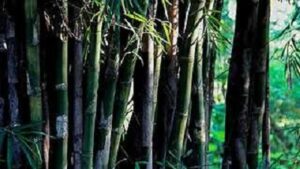
Lucky Bamboo (Dracaena sanderiana)
Lucky Bamboo is a plant that looks like bamboo. It is a succulent with faux bamboo stem, leaves and flowers. It is also a well-known houseplant that is easy to care for because it is not a high-maintenance plant and is hardy to both wet and dry conditions. If you are looking for a striking new addition to your home, you should consider this plant. This plant is also great to have on hand if you are looking to repurpose an important item such as a plant stand.
Lucky bamboo is a plant that has been around for thousands of years. It can be found in many different parts of the world, but is especially popular in Asian countries. Lucky bamboo is also called “money bamboo” because it is believed to be lucky to have one growing near you. This plant is very symbolic in many Asian cultures and is often used as a decoration or a gift for someone who has just moved into their new home.
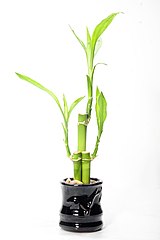
The lucky bamboo is a resilient plant that can grow in the harshest conditions. It thrives in salty, acidic, and low-nutrient soils. The lucky bamboo is able to survive because it has an amazing ability to re-sprout from its rhizome when it gets cut or torn. The lucky bamboo does not need much care, which makes it a great plant for people who live in urban areas or have a small garden.
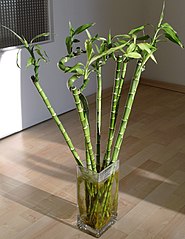
Lucky bamboo is a common indoor plant that is easy to care for and is a great decoration for any home. It is a great choice for anyone who has an allergy because it’s so easy to care for and it doesn’t have a lot of pollen. Lucky bamboo can grow up to ten feet tall, so make sure you have enough space before planting it. It can also thrive in low light and high humidity, so make sure you keep it in an area with both.
- It belongs to Asparagaceae Family.
- It is a originally lookslike a smaller version of bamboo but not a true bamboo and is perennial plant.
- It is hardy to zone 10 – 12.
Horsetail (Equisetum)
Horsetail is another plant that looks like bamboo. It’s a common plant that grows in the United States and Europe and a great plant to have in your garden. Horsetail is a great plant for your yard because it does not need a lot of care. It can grow in a variety of conditions and is a good plant for the shaded areas of your yard. Horsetail is also a great plant to have in your office.
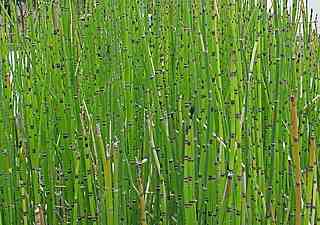
Horsetail is a type of plant that grows in wet soil and can be found in many different types of environments, including woodlands and fields. Horsetail is a common ingredient in herbal remedies that are used to treat a wide range of medical conditions, including arthritis, gout, and kidney stones.
Horsetail, also known as equisetum, is a herb that has been used for centuries for many medicinal purposes. It is a natural diuretic, meaning it helps the body get rid of toxins. Horsetail can also help with inflammation, reduce water retention, and even help improve bone health. Horsetail can be found in many different forms including powder, tablets, capsules, teas, and tinctures.
- It belongs to Berberidaceae Family.
- It is a evergreen perennial type plant.
- It is hardy to zone 6 – 9.
Heavenly Bamboo (Nandina domestica)
Heavenly bamboo is a plant that is native to Japan and China, but it has been found growing in the United States. It is a beautiful plant with long canes and large leaves that are green and fern-like. Its leaves are covered in small hairs that are a light shade of green. Heavenly bamboo is an evergreen plant with dark green leaves that only turn yellow in the fall. It has a long flower spike that grows up to 3 feet high and can be seen from a distance. The heavenly blooms can be seen in late winter until the summer. The flowers are small, white, and star-shaped with five petals.
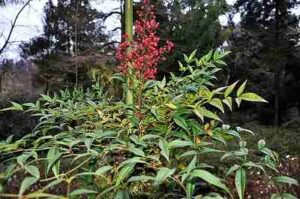
Heavenly bamboo, also known as Nandina domestica, it can grow up to six feet tall and has leaves that range in color from green to yellow. The leaves are long and wide, and they have a smooth texture. Heavenly bamboo is an attractive plant because it can be used as an ornamental plant in gardens or as a ground cover. It can also be used as a hedge or screen in areas where it is difficult to grow other plants.
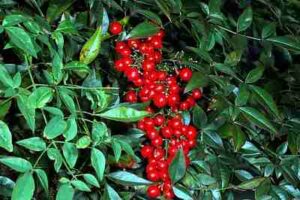
- It belongs to Berberidaceae Family.
- It is a shrub Type of plant.
- It is hardy to zone 6 to 9.
Parlor Palm (Chamaedorea elegans)
The Parlor Palm, also known as the Chamaedorea elegans, is a beautiful palm tree that is able to grow well in both warm and cool environments. It has a beautiful, delicate appearance and will grow quite tall. It is a favorite for many gardeners because of its elegance and its ability to grow in both warm and cool environments.
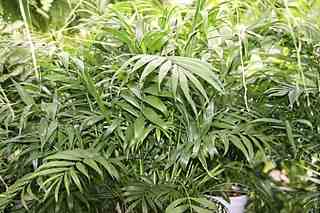
The parlor palm, also known as the dwarf fan palm, is a small, slow-growing palm that is native to the Caribbean and Florida. The palm is easy to grow and has a low-maintenance life. It is also suitable for people who have little space to grow a garden. The parlor palm grows about three feet in height and may take up to four years to mature. It is important to keep the soil moist but not wet, so remember to water your plant frequently.
- It belongs to Arecaceae Family.
- It is a slow growing houseplant plant.
- It is hardy to zone 10 – 12.
Japanese Knotweed(Fallopia japonica)
Japanese Knotweed is a perennial plant that can grow up to 6 feet tall. It is considered a weed because it invades natural areas and is difficult to control. It is also considered a pest because it can reduce the amount of light and air reaching other plants and trees. Japanese knotweed can also cause damage to buildings, foundations, and roads.
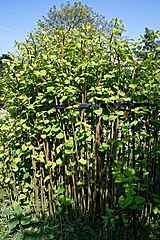
Japanese Knotweed is a plant that is native to Europe and Asia but has recently been found in the United States. It was first discovered in the United States in the 1990s and has since spread rapidly. Japanese knotweed is a type of plant that can grow up to thirty feet tall and has a thick, hollow stem. It can also spread quickly, so it is important to take precautionary measures against it.
- It belongs to Polygonaceae Family.
- It is a Herbaceous perennial type plant.
- It is hardy to zone 4 – 10.
Dumb Cane (Dieffenbachia)
The Dumb Cane, also known as Dieffenbachia, is a perennial flowering plant in the arum family. This plant is native to the tropical and subtropical regions of Asia, Africa, and the Americas. The Dumb Cane is most well-known for its use as a decorative plant in homes, offices, and hospitals. It’s also used in some religious ceremonies and for its medicinal properties. It is one of the few plants that can grow both indoors and outside. The Dumb Cane is a great houseplant that can be grown in any light condition and thrives with minimal care.

The Dieffenbachia plant is known for its beautiful and vibrant color and it also has many other uses. The Dieffenbachia plant is also known as the Dumb Cane, which is because it can be easily mistaken for a small tree. This plant is a popular indoor plant that can be found in many homes. It is easy to care for and it will bloom and bloom again. This plant is not only beautiful but also has many health benefits.
- It belongs to Araceae Family.
- It is a Herbaceous, perennial type plant.
- It is hardy to zone 10 – 12.
Giant Cane Grass(Arundo donax)
Giant Cane Grass is a type of tall and spiky grass that is native to South America. It can grow up to 10 meters tall and has been used for centuries by the natives as a source of food and building materials. In the 1950s, it was introduced to the United States as an ornamental plant, but was later abandoned when it started to spread uncontrollably and cause environmental damage. Giant Cane Grass is now considered a weed and is often found in public parks and on vacant lots.
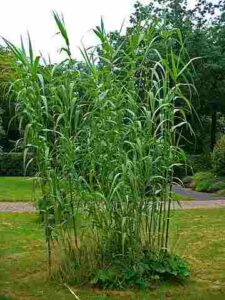
Giant Cane Grass is a type of weed that is found in places where it can grow. It can reach up to three meters in height and has a yellow stem and a dark green, thick, soft leaf. Giant Cane Grass has a deep root system and spreads its roots over wide areas. They are mostly found in the tropics, but can be seen in other areas as well.
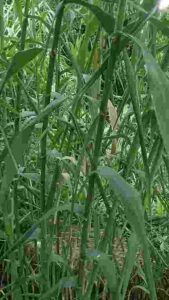
- It belongs to Poaceae Family.
- It is a perennial grass type of plant.
- It is hardy to zone 6.
Bamboo Palm (Rhapis excelsa)
The bamboo palm is a beautiful plant that has light green leaves that grow in a fan-shape. The leaves are evergreen and are very soft to the touch. The plant can grow up to 6 feet tall, with a stem that is about 1 foot wide. This palm is found in the humid tropical regions of Asia, the Pacific Islands, and Australia. This palm likes moist soil and should be planted in partial shade.
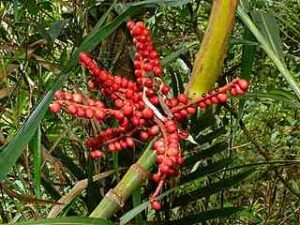
The Bamboo Palm is a tropical plant that is part of the Arecaceae family. This plant is often grown in homes because it requires little to no care, and it has a beautiful appearance. The Bamboo Palm can grow up to six feet tall and can be used for many different things such as a living fence, a living privacy screen, or a living wall. The Bamboo Palm can also be used as an ornamental plant because it has large green leaves that are very decorative.
- It belongs to Arecaceae Family.
- It is a houseplant or tree type plant.
- It is hardy to zone 8b and above zones.
Wrap Up
I hope you know about all the plant that looks like bamboo. As you already have learned that bamboo is a popular plant in the phytonutrients market. However, we know that there are so many other types of plants out there that deserve to be talked about as well. We hope you find our article informative and helpful to all plant lovers.
Also Read Similar article on Popular Grass That Looks Like Bamboo (Identify And Avoid this Mistake).
